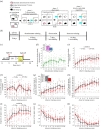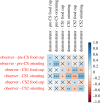Observing a trained demonstrator influences associative appetitive learning in rats
- PMID: 37063993
- PMCID: PMC10090881
- DOI: 10.1098/rsos.221224
Observing a trained demonstrator influences associative appetitive learning in rats
Abstract
The ability to acquire information about the environment through social observation or instruction is an essential form of learning in humans and other animals. Here, we assessed the ability of rats to acquire an association between a light stimulus and the presentation of a reward that is either hidden (sucrose solution) or visible (food pellet) via observation of a trained demonstrator. Subsequent training of observers on the light-reward association indicated that while observation alone was not sufficient for observers to acquire the association, contact with the reward location was higher in observers that were paired with a demonstrator. However, this was only true when the light cue predicted a sucrose reward. Additionally, we found that in the visible reward condition, levels of demonstrator orienting and food cup contact during the observation period tended to be positively correlated with the corresponding behaviour of their observer. This relationship was only seen during later sessions of observer training. Together, these results suggest that while our models were not sufficient to induce associative learning through observation alone, demonstrator behaviour during observation did influence how their paired observer's behavioural response to the cue evolved over the course of direct individual training.
Keywords: appetitive social learning; associative learning; observational learning; social learning.
© 2023 The Authors.
Conflict of interest statement
The authors have declared that no conflict of interest exists.
Figures




Similar articles
-
Observational learning in rats: Interplay between demonstrator and observer behavior.J Neurosci Methods. 2023 Mar 15;388:109807. doi: 10.1016/j.jneumeth.2023.109807. Epub 2023 Jan 31. J Neurosci Methods. 2023. PMID: 36731637
-
Socially biased learning among adult cottontop tamarins (Saguinus oedipus).Am J Primatol. 2010 Apr;72(4):287-95. doi: 10.1002/ajp.20778. Am J Primatol. 2010. PMID: 20014273
-
What to copy: the key factor of observational learning in striped jack (Pseudocaranx dentex) juveniles.Anim Cogn. 2014 Mar;17(2):495-501. doi: 10.1007/s10071-013-0686-z. Epub 2013 Oct 4. Anim Cogn. 2014. PMID: 24091646
-
From whom do animals learn? A meta-analysis on model-based social learning.Psychon Bull Rev. 2023 Jun;30(3):863-881. doi: 10.3758/s13423-022-02236-4. Epub 2023 Jan 6. Psychon Bull Rev. 2023. PMID: 36609963 Review.
-
Parallel processing of information about location in the amygdala, entorhinal cortex and hippocampus.Hippocampus. 2013 Nov;23(11):1075-83. doi: 10.1002/hipo.22179. Hippocampus. 2013. PMID: 23929819 Review.
Cited by
-
Shaping behaviors through social experience and their proposed sensitivity to stress.Learn Mem. 2024 Dec 16;31(12):a053926. doi: 10.1101/lm.053926.124. Print 2024 Dec. Learn Mem. 2024. PMID: 39681461 Review.
References
-
- Galef BG, Wigmore SW. 1983. Transfer of information concerning distant foods: a laboratory investigation of the ‘information-centre’ hypothesis. Anim. Behav. 31, 748-758. (10.1016/S0003-3472(83)80232-2) - DOI
-
- Valsecchi P, Galef J. 1989. Social influences on the food preferences of house mice (Mus musculus). Int. J. Comp. Psychol. 2, 245-256.
-
- Brown C, Laland KN. 2003. Social learning in fishes: a review. Fish Fish. 4, 280-288. (10.1046/j.1467-2979.2003.00122.x) - DOI
-
- Thornton A. 2008. Social learning about novel foods in young meerkats. Animal Behaviour 76, 1411–1421.
Associated data
LinkOut - more resources
Full Text Sources

